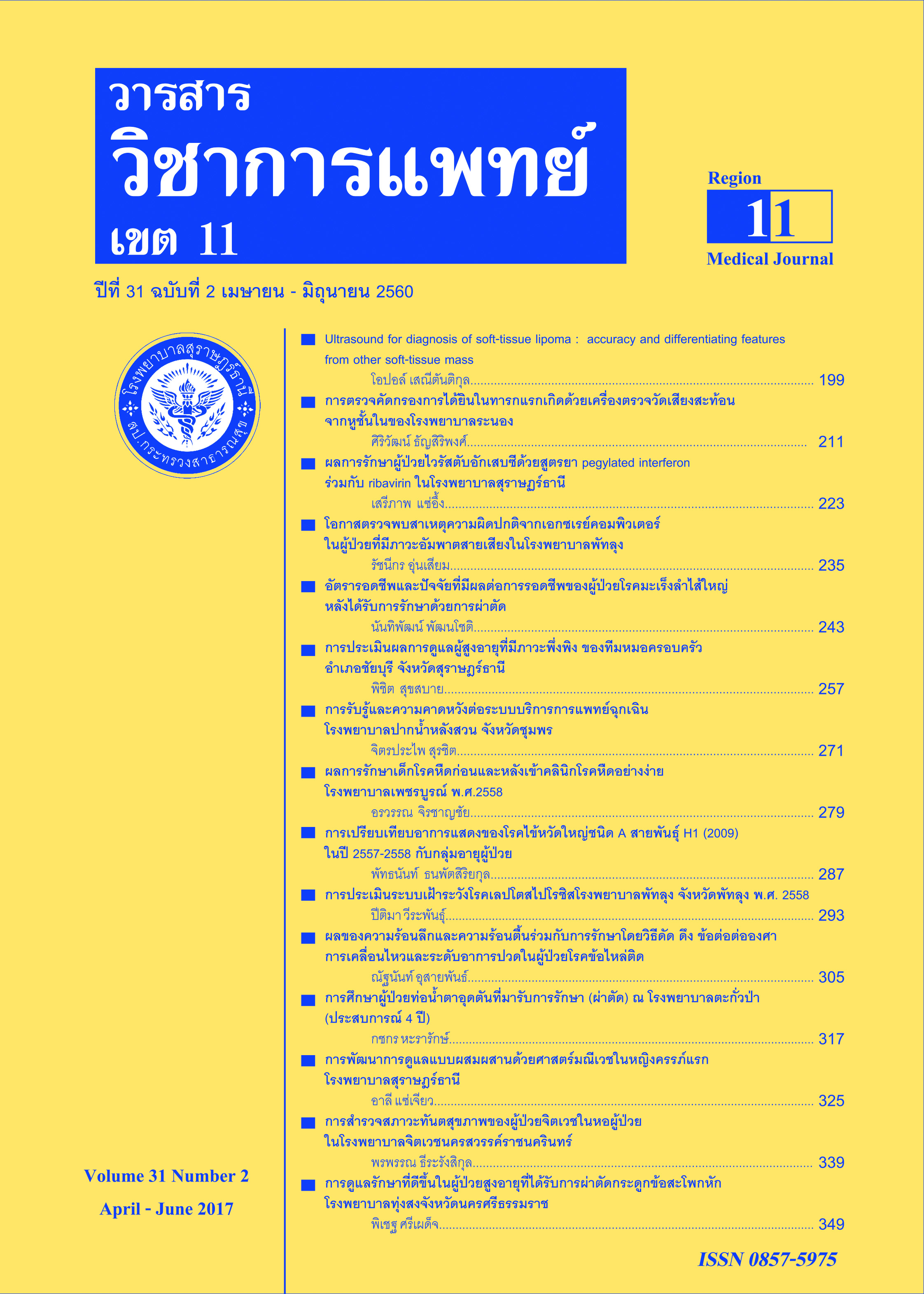Neonatal Hearing Screening using Otoacoustic Emission at Ranong Hospital
Keywords:
neonatal hearing screening, otoacoustic emission, risk factor, high risk group, low risk groupAbstract
Background : Significant hearing loss in infant is the most common disorder at birth. Early identification and when possible treated prior to 6 months of age are important, especially in high risk group
Objective : To determine the incidence and risk factor for hearing loss of newborns in a neonatal intensive care unit at Ranong Hospital
Material and method : Prospective analytic study, Data Collected from newborns in a neonatal intensive care unit between January 2015 to August 2016at Ranong Hospital . Infantwere screened with otoacoustic emissions (OAE),the results were divided into two groups, pass and refer .The infants who failed three consecutive screening tests were refered for further checks to the more potentiality hospital for confirm pathologic result and treatment.
Result: 483 newborns were screened with otoacoustic emission(OAE). There were 16newborns who failed three consecutive screening
test that refered to the tertiary hospital to confirm diagnosis. Refer rate 9.87% in high risk group and 0.3% in low risk group. This study found significant statistical relationship of the risk factor for hearing loss in high risk newborns was ototoxicity,mechanical ventilation more than 5days , very low birth weight less than 1500grams and multiple risk factor. Median age at first second and third screening in both group ( high risk and low risk) was 12,42 and 81 days respectively.
Conclusion : Neonatal hearing screening test was necessary to performed in both high risk and low risk group. The result of this study suggest the important of risk factor identification as the cause of hearing loss in NICU,to inform the healthcare providers for early investigation and intervention.
References
2. สุนันทา พลปัถพี, นิตยา เกษมโกสินทร์. ความบกพร่องทางการได้ยินในเด็ก:การฟื้นฟูสมรรถภาพเด็กพิการกรุงเทพ; 2542.หน้า217-27.
3. Yoshinaga-Itano C. Efficacy of Early Identification and Early Intervention. Seminar in Hearing, 1995;16:115-23.
4. Apuzzo ML, Yoshinaga-Itano C. Early Identification of Infants with Significant Hearing Loss and the Minnesota Child Development inventory. Seminar and Hearing,1995;16:124-139.
5. Yoshinaga-Itano C. Language of early and late identified children with hearing loss. Pediatric1998; Vol.102 No5:1161-71.
6. Downs MP,Yoshinaga-Itano C.The efficacy of early identification and intervention for children with hearing impairment.Ped Clin North Am.1998;46(1):79-87.
7. Robinshaw HM. Early intervention for hearing impairment: differences in the timing of communicative and linguistic development.1995Dec; 29(6):315-34.
8. Joint Committee on Infant Hearing. Joint Committee on Infant Hearing1994Position Statement. Pediatrics.1995;(1):152-156.
9. Joint Committee on Infant Hearing. Year2000 Position Statement: Principle and Guildlines for Early hearing detection and intervention program. Pediatrics.2000;106:798-817.
10. Joint Committee on Infant Hearing. Year 2007 Position Statement: Principle and Guildlines for Early hearing detection and intervention program. Pediatrics.2007;120:898-921.
11. Basky-Firkser L. Sun S Universal newborn hearing screening: A Three-yearexperience.Pediatrics, 1997;99:862.
12. Mehl AL.Thompson V Newborn hearing screening:The great omission. Pediatrics, 1998;101:97-8.
13. Vohr BR, Carty LM,MoorePE,Letourneau K. The Rhode island hearing assessment program: Experience with statewide hearing screening.J Pediatrics,1988;133:353-7.
14. Bamford J Davis. A neonatal hearing screening: a step towards better services for children and families. Br J Audiology,1998;32:1-6.
15. Lorenz LM.The outcome of extreme prematurity. Seminar Perinatal 2001;25:348-59.
16. Valkama AM, Laitakari KT, Tolonen EUVerynen MR,Vainionpaa LK,Koivisto ME.Prediction of permanent hearing loss in high risk preterminfants at term age.Eur J Pediatr2000;159:459-64.
17. Thompson DC,Mc Philips H,Davis R,Lieu TA,HomerCJ,Helfand M.New born hearing screening: a summary of the evidence.JAMA2001 :286:2000-10.
18. Sininger YS. Screening for hearing loss in neonates: Where do we stand? :Adv Otolaryngol Head and Neck Surg 1998;12:181-203.
19. จันทร์ชัย เจรียงประเสริฐ,กฤษณา เลิศสุขประเสริฐ, ลลิดา เกษมสุวรรณ, ประชา นันทนฤมิตร. การตรวจคัดกรองการได้ยินในทารกแรกเกิดด้วยเครื่องวัดเสียงสะท้อนจากหูชั้นใน (otoacoustic emission) ผู้ป่วยใหม่ใน1ปีของโรงพยาบาลรามาธิบดี. วารสาร หู คอ จมูกและใบหน้า2546;4:27-41.
20. วรวุฒิ โอฬารวณิช การตรวจคัดกรองการได้ยินในทารกแรกเกิดด้วยเครื่องตรวจวัดเสียงสะท้อนจากหูชั้นใน (otoacoustic emission)ของโรงพยาบาลบุรีรัมย์. วารสารการแพทย์โรงพยาบาลศรีสะเกษ สุรินทร์ บุรีรัมย์ 2554;26:2:285-94.
21. White KR,Vohr BR ,Behrens TR. Universal newborn hearing screening using transient evoked otoacoustic emission:results of the Rhode Island hearing assessment project.Seminars in hearing 14:18-29.
22. Khaimook W, Chayarpham S, Dissaneevate S.The high-risk neonatal hearing screening program in Songklanagarind Hospital. J Med Assoc Thai.2008
Jul;91(7):1038-42.
23. Wanchai T. การตรวจการคัดกรองการได้ยินในทารกแรกเกิดและกลุ่มเสี่ยงโดยใช้เครื่องวัดเสียงสะท้อนจากหูชั้นใน.พุทธชินราชเวชสาร 2551;25:618-624.
24. Kiatchoosakun P,Suphadun W, Jirapradittha J . Incidence and risk factors associated with hearing loss in high risk neonates in Srinagarind Hospital.J Med Assoc Thai.2012 Jan;95(1):52-7.
25. Korres S, Nikolopoulos TP,Komkotou V.Newborn hearing screening :effectiveness,importance of high risk factors, and characteristics of infants in the neonatal intensive care unit and well-baby nursery:Otol Neurotol.2005 Nov;26(6):1186-90 .
26. Yoshikawa S,Ikeda K, Kudo T, Kobayashi T. The effects of hypoxia, premature birth, infection, ototoxic drugs, circulatory system and congenital disease on neonatal hearing loss.Auris Nasus Larynx.2004 Dec;31(4):361-8.
27. Bielecki I,Horbulewicz A,Wolan T.Risk factors associated with hearing loss in infants: an analysis of 5282 referred neonates.Int J Pediatr Otolaryngol.
2011 Jul;75(7):925-30.
28. Raquel Mari Onoda, Marisa Frasson de Azevedo, Amelia Miyashiro Nunes dos Santos.Neonatal Hearing Screening: Failure, hearing loss and risk factor.Braz.j. Otorhinolaryngol. Vol77,no6 Sao Paulo Nov-Dec.2011.
29. Ahmen Sameh Farid. Newborn hearing screening:importance and characteristics of a high risk register in a neonatal intensive care unit.The Egyptian Journal of Otolaryngology 2012,28:17-21
30. Biswas AK,Goswami SC ,Baruah DK,Tripathy R.The potential risk factors and the identification of hearing loss in infants .Indian J Otolaryngol Head Neck Surg.2012 Sep;64(3):214-7.
31. Corujo-Santana C ,Falcon-Gonzalez JC, Borkoski - Barreiro .The relationship between neonatal hyperbilirubinemia and sensorineural hearing loss. Acta Otolaryngol Esp.2015 Jan28.
32. Korres S,Nikolopoulos T, Ferekidis E.Otoacoustic emissions in universal hearing screening: which day after birth should we examine the newborn?ORL J Otorhinolaryngol Relat Spec.2003;65(4)199-201.






